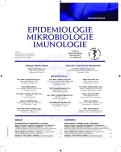Q fever – an occupational disease leading to disability – case report
Authors:
M. Nakládalová 1; R. Pastorková 2; I. Landecká 3
Authors‘ workplace:
Klinika pracovního lékařství, Lékařská fakulta UP v Olomouci
1; Ústav sociálního lékařství a zdravotní politiky, Lékařská fakulta UP v Olomouci
2; Oddělení pracovního lékařství a nemocí z povolání, Karvinská hornická nemocnice, a. s.
3
Published in:
Epidemiol. Mikrobiol. Imunol. 63, 2014, č. 2, s. 149-152
Category:
Review articles, original papers, case report
Overview
Q fever is a zoonosis caused by the bacterium Coxiella burnetii. The infection results from inhalation of infected droplets or aerosols. The most frequent sources in the Czech Republic are sheep, horses, cattles, goats, and pigs. Frequently, the disease is deemed occupational, with male sex being a risk factor for its symptomatic form.
Presented is a case of a 27-year-old male diagnosed with a chronic form of Q fever after six months of worsening symptoms. Even years later, his condition is manifested as osteoarthritis, granulomatous hepatitis, and microcytic hypochromic anemia.
The source of infection was probably animal food stored in a facility where the patient was employed. He was recognized as having an occupational disease and being disabled, especially due to his severely impaired mobility.
Keywords:
Q fever – Coxiella burnetii – osteoarthritis – occupational disease – disability
Sources
1. Stein A, Raoult D. Pigeon pneumonia in Provence: A bird-borne Q fever outbreak. Clinical Infectious Disease, 1999;29,3:617–620.
2. Maurin M, Raoult D. Q fever. Clinical Microbiology Reviews, 1999;12, 4:518–553.
3. Euzéby J. P. List of bacterial names with standing in nomenclature: a Folder Available on the Internet. International Journal of Systematic Bacteriology, 1997;47,2:590–592. List of prokaryotic names with standing in nomenclature [online]. c1997-2013 [cit. 2013-10-07]. Dostupné na www: http://www.bacterio.net/coxiella.html >.
4. Parker NR, Barralet JH, Bell AM. Q fever. Lancet, 2006, vol. 367, p. 679–688.
5. Raoult D, Marrie T, Mege J. Natural history and pathophysiology of Q fever. Lancet Infectious Disease, 2005;5,4:219–226.
6. Gami AS, Antonios VS, Thompson RL, et al. Qfever endocarditis in the United States. Mayo Clinic Proceedings, 2004;79,2:253–257.
7. McQuiston JH, Holman RC, McCall CL, Childs JE, et al. National surveillance and the epidemiology of human Q fever in the United States, 1978–2004. American Journal of Tropical Medicine and Hygiene, 2006;75,1:36–40.
8. Dorko E, Čisláková L, Kizek P. Q horúčka – klinický obraz. Praktický lékař, 2005;85,7:382-384.
9. Votava, M. Q-horečka: vlastnosti původce. Praktický lékař, 2005;85,7:385–387.
10. Madariaga MG, Rezai K, Trenholme GM, Weinstein RA. Q fever: a biological weaponin your backyard. Lancet Infectious Diseases, 2003;3,3:709–721.
11. Kermode M, Yong K, Hurley S, Marmion B. An economic evaluation of increased uptake in Q fever vaccination among meat and agricultural industry workers following implementation of the National Q Fever Management Program. Australian and New Zealand Journal of Public Health, 2003;27,4:390–398.
12. Comer JA, Paddock CD, Childs JE. Urban zoonoses caused by Bartonella, Coxiella, Ehrlichia, and Rickettsia species. Vector Borne Zoonotic Disease, 2001;1,2:91–118.
13. Landais C, Fenollar F, Constantin A, et al. Q fever osteoarticular infection: four new cases and a review of the literature. European Journal of Clinical Microbiology and Infectious Diseases, 2007;26,5:341–347.
14. Karakousis PC, Trucksis M, Dumler JS. Chronic Q Fever in the United States. Journal of Clinical Microbiology, 2006;44,6:2283–2287. Dostupný na www: <http://www.ncbi.nlm.nih.gov/pmc/articles/PMC1489455/>.
15. Reid A, Malone J. Q fever in Ireland. A seroprevalence study of exposure to Coxiella bumettii among Department of Agriculture workers. Occupational Medicine, 2004;54,8:544–547.
Labels
Hygiene and epidemiology Medical virology Clinical microbiologyArticle was published in
Epidemiology, Microbiology, Immunology

2014 Issue 2
Most read in this issue
- A point prevalence survey of healthcare-associated infections in the Slovak Republic – a part of the EU project
- Candida dubliniensis in clinical specimens and possibilities for identification
- Q fever – an occupational disease leading to disability – case report
- Diagnosis of Clostridium difficile infections: Comparative study of two immuno enzyme assays with confirmation by PCR and culture followed by PCR ribotyping
